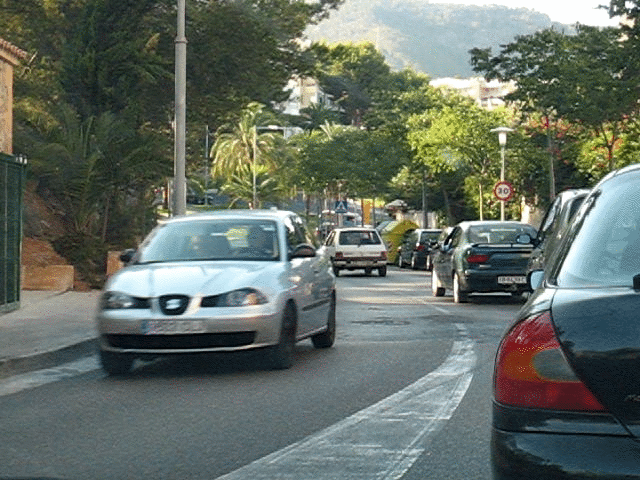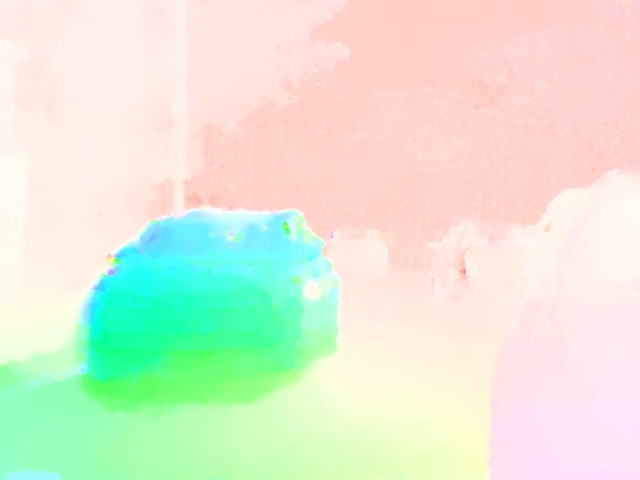Team: Shiyu Huang, Hongxiang Qiu, Zeyu Zhao, Zongren Zou
This README focuses on how to run our code and reproduce our results. For background, analysis, detailed results, and etc. (i.e. the report) see our project website.
Table of Contents
Optical Flow describes the motion of objects between two consecutive images. There're sparse optical flow (flow for feature sets) and dense optical flow (flow for all pixels). DeepFlow is a dense optical flow algorithm based on DeepMatching, which calculates dense correspondences between two images (so the flow is more accurate). For images without large displacement, it's actually OK to run deepflow without deep matching. But in our project, we run deep matching for each pair of frames.
Below is a visualization example of the optical flow.
| Images | Flow |
|---|---|
 |
 |
(source: https://people.csail.mit.edu/celiu/OpticalFlow/)
For more details, see our project website.
As mentioned above, DeepMatching result is a part of the input of DeepFlow. You should download DeepMatching and compile it on your machine. The following guide assumes the compiled executable has name deepmatching and assumes you are using the OpenMP implementation provided in the official website. For the GPU implementation, the execution command should be similar.
If you just want to test the software, you can skip this section and use our sample data.
Suppose two images have name 1.jpg and 2.jpg. To generate forward_1_2.match, you should run command:
./deepmatching 1.jpg 2.jpg -nt 10 > forward_1_2.match-nt 10 means running with 10 threads.
For your convenience, we provide sample images ak1.ppm, ak2.ppm and the ak1 to ak2 match ak_forward.match.
You need ffmpeg to extract frames from a video. You can install ffmpeg in Ubuntu with apt-get command, similar in other Unix-like systems.
Suppose you have video example.mp4, and you want to extract frames into out folder.
mkdir out
ffmpeg -i example.mp4 out/frame_%06d.ppmYou can also extract the first 180 seconds and change the output resolution to 640x360. The command is:
mkdir out
ffmpeg -i bunny.mp4 -t 180 -vf scale=640:360 out/frame_%06d.ppmThen you can use our bash script to generate all forward and backward matches for all pairs of frames. This script is HPC-ready, you can sbatch deepmatching-video.sh in Slurm HPC. The matches will be in match folder.
For your convenience, we provide sample video frames (360p, 720p, 1080p) and corresponding pairwise matchings (360p, 720p, 1080p). In addition, we have a very short 720p bullet video sample (frames and matches), which is used to generate our application examples.
This is how to run our model part. The guide assumes you use AWS m4.2xlarge node (AWS g3.4xlarge for OpenACC) with Ubuntu Server 16.04 LTS (HVM).
We have a seperate guide to run MapReduce, see here
If you followed the previous section or downloaded our samples, you should now have:
- For a pair of image
- Two image files (our sample is
ak1.ppm,ak2.ppm) - One match file (our sample is
ak_forward.match)
- Two image files (our sample is
- For a video
- A folder named
outcontaining all frames - A folder named
matchcontaining all matches
- A folder named
The command to download our sample data is:
wget https://github.com/zeruniverse/CS205-project/releases/download/0.01/ak1.ppm
wget https://github.com/zeruniverse/CS205-project/releases/download/0.01/ak2.ppm
wget https://github.com/zeruniverse/CS205-project/releases/download/0.01/ak_forward.match
wget https://github.com/zeruniverse/CS205-project/releases/download/0.01/bunny_640x360_frame.zip
wget https://github.com/zeruniverse/CS205-project/releases/download/0.01/bunny_640x360_match.zip
unzip bunny_640x360_frame.zip
unzip bunny_640x360_match.zipFirst, you should install required packages:
sudo apt-get update
sudo apt-get install -y cmake
sudo apt-get install -y build-essential
sudo apt-get install -y libjpeg-dev
sudo apt-get install -y libpng-dev
sudo apt-get install -y unzipIf you are using other (old) systems, please ensure you have new gcc and g++, otherwise, you might get compile error of error: ‘for’ loop initial declarations are only allowed in C99 mode.
After completing above steps, you can compile DeepFlow. Here, we use RBSOR_OMP implementation as example, all *_OMP and *_serial implementations under src can be compiled and executed in the same manner.
Compile it:
git clone https://github.com/zeruniverse/CS205-project.git
cd CS205-project/src/RBSOR_OMP
mkdir build
cd build
cmake ..
make
# Now you have the executable deepflow2, move it to the place of your data
mv deepflow2 ../../../..
cd ../../../..The command below generates the flow flow.flo and output the execution time.
export OMP_NUM_THREADS=4
time ./deepflow2 ak1.ppm ak2.ppm flow.flo -match ak_forward.matchYou can use the video_flow.sh in each implementation folder. Please note you should have out and match folder containing the video data.
# copy video_flow.sh here
cp CS205-project/src/RBSOR_OMP/video_flow.sh .
bash video_flow.shIn the terminal, you can see accumulated time cost after the completion of each pair of frames. The flow results are stored in the flow folder.
First follow the course guide to install pgcc in g3.4xlarge node and then install libraries described above.
We use RBSOR_ACC implementation as example, all *_ACC can be compiled and executed in the same manner.
Compile it:
cd CS205-project/src/RBSOR_ACC
bash compile_acc.shCopy the executable (under build) and video_flow.sh to the place of your data, running commands for images and videos are same with [Serial and OpenMP](README.md#generate-flow-for-two-images).
First follor the course guide to install mpicc and then install libraries described above.
We use RBSOR_MPI implementation as example. RBSOR_MPI_OMP can be compiled and executed similarly.
Compile:
cd CS205-project/src/RBSOR_MPI
bash compile_mpi.sh
Copy the executable (under build) and video_flow.sh to the place of your data, and use commands mpirun -np 4 to run the program, while 4 is the number of threads you want to use (for video, simply run video_flow.sh). Notice that it is a guide for running this program on a single instance.
To check the correctness of the generated flows, you might want to use this tool to visualize them.
cd tools/flo_visualization/imageLib
make
cd ..
make
./color_flow path/to/flo vis.pngvis.png is the visualization file.
Below is a complete test case for 2 images (OpenMP). For videos, the command should be similar (actually easier) because you just run bash file we provided (see above).
Before running the following commands in your terminal, make sure you have latest cmake, gcc and g++ with libraries at the beginning of this section.
git clone https://github.com/zeruniverse/CS205-project.git
cd CS205-project/tools/flo_visualization/imageLib
make
cd ..
make
cp color_flow ../../src/RBSOR_OMP/
cd ../../src/RBSOR_OMP/
mkdir build
cd build
cmake ..
make
cp deepflow2 ../
cd ..
export OMP_NUM_THREADS=4
wget https://github.com/zeruniverse/CS205-project/releases/download/0.01/ak1.ppm
wget https://github.com/zeruniverse/CS205-project/releases/download/0.01/ak2.ppm
wget https://github.com/zeruniverse/CS205-project/releases/download/0.01/ak_forward.match
time ./deepflow2 ak1.ppm ak2.ppm flow.flo -match ak_forward.match
./color_flow flow.flo flow.png
lsthe ls command should give you flow.png (CS205-project/src/RBSOR_OMP/flow.png). This is the visualization of the flow between ak1.ppm and ak2.ppm. Check it with any image viewer of your choice. It should look the same with the following:
We present two applications of deepflow on video which will benefit from the parallelization.
Video stylization tries to apply the style of a paint to a video and DeepFlow is used to keep temporal consistency. The existing implementation uses DeepFlow by default so simply replacing the deepflow executable with our parallelized executable will work. A short guide is here.
We provide a sample video and its stylized result with the paint Starry Night.
Fake slow motion video can be generated by interpolating in-between frames using optical flow. SlowmoVideo is a software to generate such videos. However, it uses Farneback algorithm. To use DeepFlow, you need our tool and then follow this guide.
We provide a sample video and its slowed-down version generated by SlomoVideo and DeepFlow.
DeepMatching: Hierarchical Deformable Dense Matching (IJCV 2016)
DeepFlow: Large displacement optical flow with deep matching (ICCV 2013)
DeepMatching and DeepFlow code
Artistic Style Transfer for Videos
Iterative Methods for Solving Ax = b - The SOR Method
Parallel SOR Iterative Algorithms and Performance Evaluation on a Linux Cluster


